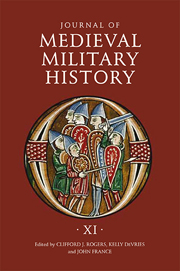Book contents
- Frontmatter
- Contents
- List of Illustrations and Tables
- 1 Military Games and the Training of the Infantry
- 2 The Battle of Civitate: A Plausible Account
- 3 The Square “Fighting March” of the Crusaders at the battle of Ascalon (1099)
- 4 How the Crusades Could Have Been Won: King Baldwin II of Jerusalem's Campaigns against Aleppo (1124–5) and Damascus (1129)
- 5 Saint Catherine's Day Miracle – the Battle of Montgisard
- 6 The Military Effectiveness of Alan Mercenaries in Byzantium, 1301–1306
- 7 Winning and Recalling Honor in Spain: Pro-English Poetry in Celebration of the Battle of Nájera (1367)
- 8 The Wars and the Army of the Duke of Cephalonia Carlo I Tocco (c. 1375–1429)
- 9 Sir John Radcliffe, K.G. (d. 1441): Miles Famossissimus
- 10 Defense Schemes of Southampton in the Late Medieval Period, 1300–1500
- 11 French and English Acceptance of Medieval Gunpowder Weaponry
- Journal of Medieval Military History 1477–545X
3 - The Square “Fighting March” of the Crusaders at the battle of Ascalon (1099)
Published online by Cambridge University Press: 05 October 2013
- Frontmatter
- Contents
- List of Illustrations and Tables
- 1 Military Games and the Training of the Infantry
- 2 The Battle of Civitate: A Plausible Account
- 3 The Square “Fighting March” of the Crusaders at the battle of Ascalon (1099)
- 4 How the Crusades Could Have Been Won: King Baldwin II of Jerusalem's Campaigns against Aleppo (1124–5) and Damascus (1129)
- 5 Saint Catherine's Day Miracle – the Battle of Montgisard
- 6 The Military Effectiveness of Alan Mercenaries in Byzantium, 1301–1306
- 7 Winning and Recalling Honor in Spain: Pro-English Poetry in Celebration of the Battle of Nájera (1367)
- 8 The Wars and the Army of the Duke of Cephalonia Carlo I Tocco (c. 1375–1429)
- 9 Sir John Radcliffe, K.G. (d. 1441): Miles Famossissimus
- 10 Defense Schemes of Southampton in the Late Medieval Period, 1300–1500
- 11 French and English Acceptance of Medieval Gunpowder Weaponry
- Journal of Medieval Military History 1477–545X
Summary
On 12 August 1099 the Latin knights and footsoldiers of the First Crusade left Jerusalem to meet the Fatimid army of the grand vizier Al-Afdal which, at that time, had invaded Judaea and had encamped close to the coastal city of Ascalon. The army was estimated to be around twenty thousand strong, including both infantry and cavalry. This would be the first of several major expeditions by the Egyptians launched against the Crusader states in Palestine, all entering through Ascalon and its coastal plain. The Latin leaders were first alerted about a possible large enemy force approaching from the south on 9 August and on the next day the Crusader armies began their forty-kilometer march south to the city of Ascalon where the enemy was last reported to have camped. According to Raymond of Aguilers, one of the main chroniclers of the First Crusade and an eye witness of the events, the Latins numbered 1,200 knights and no more than 9,000 footsoldiers and “they marched in nine ranks, three to the rear, three to the front, and three in the middle so that attack would be met in three ranks with the middle one always available to bolster the others.”
In this paper I will examine a number of theories about the origin of this particular marching formation, based on the manuals attributed to the Byzantine Emperors Maurice (582–602), Leo VI (886–912) and Nicephoros Phocas (963–69) and several anonymous Byzantine military treatises of the sixth and tenth centuries.
- Type
- Chapter
- Information
- Journal of Medieval Military HistoryVolume XI, pp. 57 - 72Publisher: Boydell & BrewerPrint publication year: 2013

